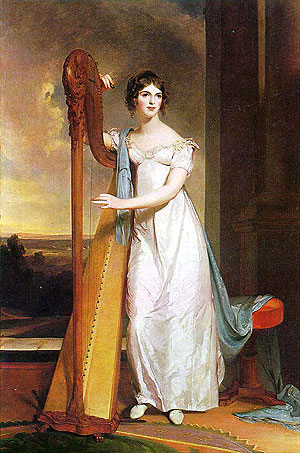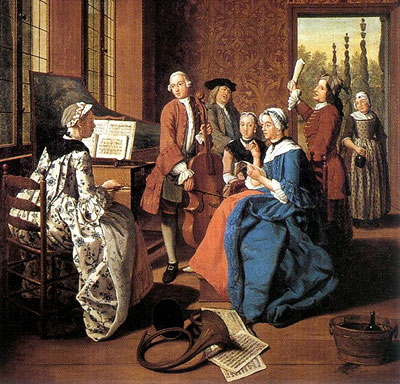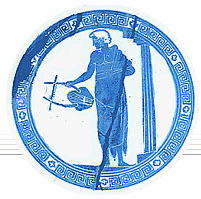|
THE CLASSICAL PERIOD
| CLASSICAL
PERIOD (1750-1825) |
 |
|
 |
The
span of time when music was written from 1750 (the death of
Bach) to 1827 (the death of Beethoven). The Classical period
was a time of change in feelings and ideas. People wanted
a say in their own self-determination, social injustice was
not tolerated, public morality was espoused and it was the
beginnings of the Age of Revolution, when people started speaking
out against what they didn’t like. The social and political
movement that best represented this new way of thinking was
called the Enlightenment. Followers believed that reason and
man’s natural good were enough to improve the quality
of life. Revolutions overthrew the social structure in both
France and America in order to establish a more democratic
way of governing and to insure that the concepts of the Enlightenment
prevailed. Governments were being measured not by how powerful
or rich they were but by what good they could do for the citizens
that lived by them. During the Enlightenment (1730-1780),
the middle class with its needs and wants rose to the forefront
in European society. Such things as universal education, political
power (self-determination), an end to social and religious
injustice, a new concern for the quality of life on earth
as important as the afterlife made up the "pursuit of
happiness" and entertainment.
 |
 |
"Lady
with a Harp: Eliza Ridgely",
portrait by Thomas Sully, 1818 |
These
changes were reflected in the music of the times. Music was
written to be more accessible, less complicated, more popular
and pleasing. Music became one of the main recreations for
the powerful middle class. Partly in reaction to the notey
extravagance and the decorated art of the Baroque and partly
due to the new ideas of the "Pursuit of Happiness,"
music became more "natural," simpler and uncluttered.
Polyphony, which had been evolving from the Middle Ages, suddenly
stopped and clearly defined tunes with suitable accompaniment
(homophony) replaced it. The predominant homophonic texture
allowed composers to exploit and emphasize cadence. Music
was consumed by a literate population interested in music
as a hobby, as a diversion and for a simple, easy and pleasant
activity.
The
Classical period takes its name after the art and literature
of ancient Greece and Rome emphasizing order, clarity and
restraint. In the music of the classical period the clearly
defined phases put into predictable forms produced a balance
of voices and symmetry. Because so many of the composer of
the period lived and worked in Vienna, the age is sometimes
referred to as the Viennese Classical period. Composer-performers
include: Franz Joseph Haydn, Wolfgang Amadeus Mozart and the
early works of Beethoven.
The
texture in the Classical period was primarily homophonic (whereas
Baroque era works were polyphonic). The emphasis was on clearly
defined phrases, tuneful melodies, flexible rhythms (less
motoric than that of Baroque era music), more and varied dynamics
and larger more standard and integrated orchestras.
| CADENCE |
 |
|
 |
A
cadence is a melodic or harmonic passage occurring at the
end of a phase, section, passage or composition that conveys
a temporary or final sense of conclusion. A cadence is a musical
punctuation mark. In homophonic music and in the homophonic
forms of the classical period, composers exploited and utilized
cadences to their max. There are three types of cadences in
Classical music, closed, open and deceptive.
 Closed Cadence
Closed Cadence
A
closed cadence is one in which the music ends on the tonic
and resolves off the chord of of tension (the dominant). A
closed cadence creates a sense of rest and resolution. A closed
cadence is equivalent to a period in punctuation.
Listen
to a Closed Cadence.
Listen to two Closed Cadences.
Listen to the coda and great final Closed
Cadence in Symphony No. 5 of Beethoven.
 Open Cadence
Open Cadence
An
open cadence is one where the music gets hung up on the chord
of tension (the dominant chord five steps away from the tonic).
Without resolving to the tonic, like in a closed cadence,
an open cadence creates tension and a need to resolve or continue.
An open cadence is equivalent to a comma in punctuation
Listen
to an Open Cadence.
Listen to the Dominant chord.
Listen
to the Tonic Chord.
Listen
to the Dominant to Tonic chords.
 Deceptive Cadence
Deceptive Cadence
A
deceptive cadence is one that resolves but not were you expect
it to. In a deceptive cadence the music keeps going in search
of the tonic. A deceptive cadence is equivalent to a semicolon
in punctuation.
Listen
to a Deceptive Cadence.
Listen
to the Deceptive Cadence in Symphony No. 5 of Beethoven.
Listen
to what Beethoven doesn't do (closed cadence).
Listen
to what Beethoven does do (deceptive cadence).
| FORM
IN CLASSICAL MUSIC |
 |
|
 |

Horemans, Jan Jozef II, Concert in an Interior, 1764,
Rockox House, Antwerp |
Remember
that form relates to the organization of music, its structure
or plan. During the classical period composers were pre-occupied
with musical form as well as cadences. The classical composers
wanted their audience to easily recognize the shape, arrangement
and relationship of various musical elements within a piece.
Therefore composers strove to make the sections or their pieces
relate to each other through statement, departure or return.
The tempo and the formal plan of a symphony, string quartet
or a piano sonata was conceived in a very predictable and
routine way. Most classical symphonies, string quartets and
piano sonatas have the following tempo and formal plan.
 |
TEMPO
|
|
 |
 |
FORM |
| I |
Allegro
|
 |
- |
|
Sonata
form |
| II |
Adagio |
|
- |
|
ABA
or Variation form |
| III |
Moderato |
|
- |
|
Minuet
and Trio form |
| IV |
Presto |
|
- |
|
Rondo
form |
| VARIATION
FORM |
 |
|
 |
The
Classical era variation form has the principal melody (or
theme) in the upper voice or top notes of the composition.
The Baroque variation (ground bass or passacaglia) found the
theme in the lowest voice of bass line. The Classical era
composers were taking a simple tune and expressing it in as
many moods as possible yet keeping that tune through ally
discernable. The Baroque era variation or ground bass was
in polyphonic texture but the Classical era variation was
in homophonic texture. The bass lines in the Classical era
were to underpin the harmony or chords. If the bass was too
elaborate it was considered distracting.
Ways
of varying the melody in variation form typically involves:
 Changing the mode (major
to minor)
Changing the mode (major
to minor)
 Changing the texture (homophonic
to polyphonic)
Changing the texture (homophonic
to polyphonic)
 Changing the accompaniment (Alberti
type bass to fast arpeggios
Changing the accompaniment (Alberti
type bass to fast arpeggios
 embedding
the melody) embedding
the melody)
 Changing the meter (duple
to triple)
Changing the meter (duple
to triple)
 Changing the register (high
to low)
Changing the register (high
to low)
 Changing the harmony (modulations)
Changing the harmony (modulations)
 Embedding the melody (theme
is buried in accompaniment)
Embedding the melody (theme
is buried in accompaniment)
 Hocket – The
medieval device where a melody plays off itself like two people
Hocket – The
medieval device where a melody plays off itself like two people
 singing
the same melody at different times. singing
the same melody at different times.
Variation
form typically ends with a Coda or “tail.”
A coda is a short section found at the end of a composition
that reinforces the conclusion and extends the final cadence
by using many closed cadences.
Variation
form is highly sectional and is diagrammed A A1 A2
A3 A4 A5 A6 A7 A8 etc. There is no fixed number of
variations and usually there is any where between 4 and 30
variations. Beethoven’s Diabelli Variations have 33
and Brahms's Handel variations have 27 and the Brahms then
end with a gigantic fugue. Variation form never departs from
the theme and the theme never changes, although aspects of
the theme change (listed above). The form consists of the
same idea presented differently over and over again. Each
variation ends with a closed cadence. Also, variation form
is non dramatic because it keeps stopping and never creates
emotional momentum. Nevertheless it is a highly interesting
form and is often used to show off the virtuosity and cleverness
of a composer as he or she redresses a single idea. It also
serves as a vehicle well as a performer.
In
Mozart's Piano Concerto No. 17 in G, K. 453
*, Mozart scores the theme for the orchestra first
and then has the piano soloist play the first variation.
*
Mozart's works are identified by K numbers, after the chronological
catalog of his works compiled by Ludwig von Kochel (pronounced Kershal). Finished
in 1862 the catalog listed 626 works composed by Mozart in
his short lifetime. (1756-1791).
| 




